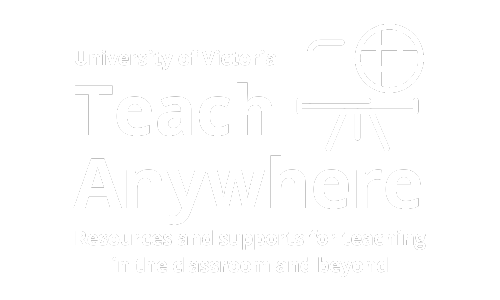What is learning?
- Student learning is a relatively permanent (not transient) change in students’ knowledge, skills, beliefs, and attitudes
- Student learning is a process (not a product) inferred from what the student does
- Student learning arises from what the student does and experiences (Ambrose et al., 2010)
At UVic, we take a learning-centred approach to teaching that focuses on students and their learning rather than on instructor control and coverage of academic content. A learning-centred approach does the following:
- engages students in the hard messy work of learning;
- includes explicit skill instruction;
- encourages students to reflect on what they are learning and how they are learning it;
- motivates students by giving them some control over learning processes; and
- encourages collaboration (Weimer, 2013).
What do learning-centred instructional strategies look like?
Learning-centred instructional strategies focus on students doing; therefore active learning. There are too many strategies to list here. However, the following resources will help guide you to some strategies that you can use for your course to meet your intended learning outcomes.
How Learning Works: 7 Research-Based Principles for Smart Teaching is an excellent online resource available through the UVic library. In this book, you will find well-researched principles discussed with a multitude of strategies to use in your teaching.
Universal Design for Learning (UDL) is a research-based framework developed by the Centre for Applied Special Technology (CAST) that guides instructors to incorporate strategies for delivering instruction, reduce student learning barriers, and provides students with opportunities to demonstrate their knowledge in a variety of ways.
An ePortfolio is an online tool that students can use to compile examples of their learning and experiences, reflect on these to deeper understand them, find connections between them and also present them to others. Examples of work, often called artifacts, are stored electronically in a variety of forms, such as videos, downloadable documents, pictures of experiences or work. Like many technological tools, the concept of ePortfolios is consistently evolving and many different terms are used interchangeably with the term ePortfolio, such as digital or electronic portfolio, online dossier, or even simply a personal or professional website.
Consider enrolling in our Faculty Institute of Teaching (FIT), workshops and events to continually learn about other instructional strategies suitable for in the classroom or online.
References
- Ambrose, S. A., Bridges, M. W., DiPietro, M., Lovett, M. C., & Norman, M. K. (2010). How learning works: Seven research-based principles for smart teaching. Jossey-Bass.
- Weimer, M. (2013). Learner-centered teaching: Five key changes to practice. (2nd Ed.). San Francisco: Jossey-Bass.
